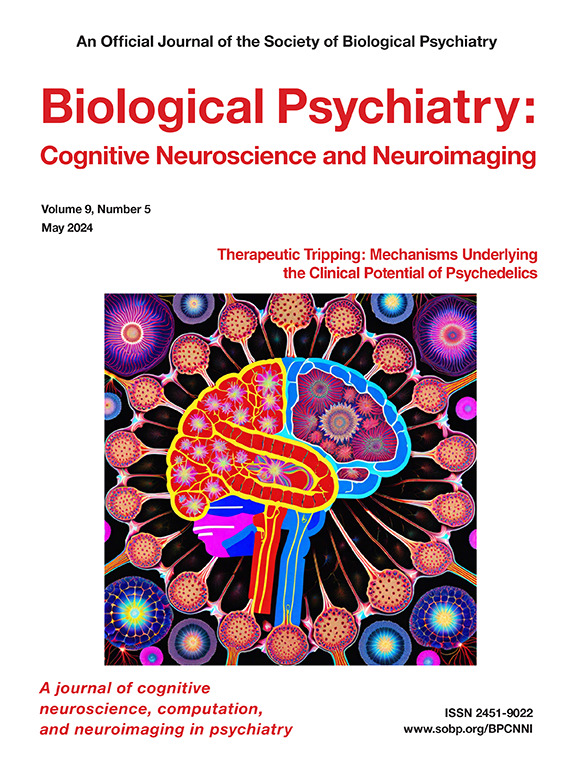大流行相关压力与高危青少年 COVID-19 期间内化症状之间关系的大脑形态宏观结构调节器。
IF 5.7
2区 医学
Q1 NEUROSCIENCES
Biological Psychiatry-Cognitive Neuroscience and Neuroimaging
Pub Date : 2024-11-01
DOI:10.1016/j.bpsc.2024.07.002
引用次数: 0
摘要
背景:根据 "因人因环境 "模型,个体特质的差异可能会缓和压力因素与心理病理学发展之间的关联;然而,文献中的研究结果并不一致,很少有文献研究青少年的大脑结构是压力对青少年内化症状影响的调节因素。COVID-19 大流行为研究压力、大脑结构和心理病理学之间的关联提供了一个独特的机会。考虑到大脑皮层形态与青少年抑郁和焦虑之间的联系,本研究调查了大脑皮层形态是否会调节 COVID-19 大流行所带来的压力与家族性高危青少年内化症状发展之间的关系:在 COVID-19 大流行之前,72 名青少年(27 岁)完成了抑郁和焦虑症状的测量,并接受了磁共振成像检查。采集 T1 加权图像以评估皮质厚度和表面积。在COVID-19被宣布为全球性流行病约6-8个月后,青少年报告了他们的抑郁和焦虑症状以及与流行病有关的压力:结果:在对大流行前的抑郁症状、焦虑症状和压力进行调整后,大流行相关压力的增加与抑郁症状的增加有关,但与焦虑症状无关。这种关系受前扣带回皮质厚度和表面积以及内侧眶额皮质厚度的调节,因此只有在这些区域皮质表面积较低而皮质厚度较高的青少年中,压力增加才与抑郁和焦虑症状的增加有关:研究结果进一步加深了我们对压力与内化症状之间的神经脆弱性的理解,尤其是在COVID-19大流行期间。本文章由计算机程序翻译,如有差异,请以英文原文为准。
Macrostructural Brain Morphology as Moderator of the Relationship Between Pandemic-Related Stress and Internalizing Symptomology During COVID-19 in High-Risk Adolescents
Background
According to person-by-environment models, individual differences in traits may moderate the association between stressors and the development of psychopathology; however, findings in the literature have been inconsistent and little literature has examined adolescent brain structure as a moderator of the effects of stress on adolescent internalizing symptoms. The COVID-19 pandemic presented a unique opportunity to examine the associations between stress, brain structure, and psychopathology. Given links of cortical morphology with adolescent depression and anxiety, the current study investigated whether cortical morphology moderated the relationship between stress from the COVID-19 pandemic and the development of internalizing symptoms in familial high-risk adolescents.
Methods
Prior to the COVID-19 pandemic, 72 adolescents (27 male) completed a measure of depressive and anxiety symptoms and underwent magnetic resonance imaging. T1-weighted images were acquired to assess cortical thickness and surface area. Approximately 6 to 8 months after COVID-19 was declared a global pandemic, adolescents reported their depressive and anxiety symptoms and pandemic-related stress.
Results
Adjusting for pre-pandemic depressive and anxiety symptoms and stress, increased pandemic-related stress was associated with increased depressive but not anxiety symptoms. This relationship was moderated by cortical thickness and surface area in the anterior cingulate and cortical thickness in the medial orbitofrontal cortex such that increased stress was only associated with increased depressive and anxiety symptoms among adolescents with lower cortical surface area and higher cortical thickness in these regions.
Conclusions
Results further our understanding of neural vulnerabilities to the associations between stress and internalizing symptoms in general and during the COVID-19 pandemic in particular.
求助全文
通过发布文献求助,成功后即可免费获取论文全文。
去求助
来源期刊

Biological Psychiatry-Cognitive Neuroscience and Neuroimaging
Neuroscience-Biological Psychiatry
CiteScore
10.40
自引率
1.70%
发文量
247
审稿时长
30 days
期刊介绍:
Biological Psychiatry: Cognitive Neuroscience and Neuroimaging is an official journal of the Society for Biological Psychiatry, whose purpose is to promote excellence in scientific research and education in fields that investigate the nature, causes, mechanisms, and treatments of disorders of thought, emotion, or behavior. In accord with this mission, this peer-reviewed, rapid-publication, international journal focuses on studies using the tools and constructs of cognitive neuroscience, including the full range of non-invasive neuroimaging and human extra- and intracranial physiological recording methodologies. It publishes both basic and clinical studies, including those that incorporate genetic data, pharmacological challenges, and computational modeling approaches. The journal publishes novel results of original research which represent an important new lead or significant impact on the field. Reviews and commentaries that focus on topics of current research and interest are also encouraged.
 求助内容:
求助内容: 应助结果提醒方式:
应助结果提醒方式:


